Rare plants of Russia: photos
Here are five plants that your grandchildren may not see. The number of some reaches only a few dozen.
Nepenthes attenborough
Nepenthes attenborough Flickr
These amazing "cups" are predators that feed on insects. Nepenthes grows on the island of Palawan (Philippines) and on the slopes of Mount Victoria. Nepenthes attenboroughii is a woody shrub that reaches 1.5 meters in height. The average dimensions of its “jugs” are about 25 cm in length and 12 cm in width. This plant was first discovered by Christian missionaries trying to conquer Victoria Peak in 2000, then - in 2007 - described by an expedition of biologists.
The largest pitcher flower found is a 1.5-liter “cup.” It is not surprising that cases have been recorded where not only insects, but also small rodents fell into such a trap.
The International Union for Conservation of Nature considers this plant to be endangered due to its small distribution area and poaching.
"Suicide Palm"

Tahina spectabilis / Flickr
This is the name of the Madagascar Tahina palm. In addition to being included in the list of the ten most remarkable species of 2009 (according to the International Institute for Species Research), it was also included in the list of the most endangered in 2012 (according to the International Union for Conservation of Nature). The biggest threat to this tree is active deforestation of the jungle and Forest fires(besides its own slow reproduction).
The palm tree grows in only one place on Earth - in the Analalawa region in northwestern Madagascar. With a height of 18 meters, it is considered the largest palm tree on the island.
Tahina spectabilis, in fact, bears fruit only before its death, blooming at 30-50 years. The fruiting process takes too much energy from the tree, so after it is completed the palm dries out. As of 2012, only thirty mature Tahina palms remained in Madagascar.
Risantella Gardner
Medusagyne oppositifolia are the only representatives of the Medusagyne family. The plant received this name due to the resemblance of the fruit to a jellyfish. The tree reaches 9 meters in height and grows only on the island of Mahe (Seychelles). And even there it is extremely difficult to see it, since the jellyfish chooses hard-to-reach rock crevices. This plant is not only rare - it was even considered extinct until it was rediscovered in the 1970s. Today there are up to 90 mature trees, many of which have already lost their ability to bear fruit.
Mammillaria herrera
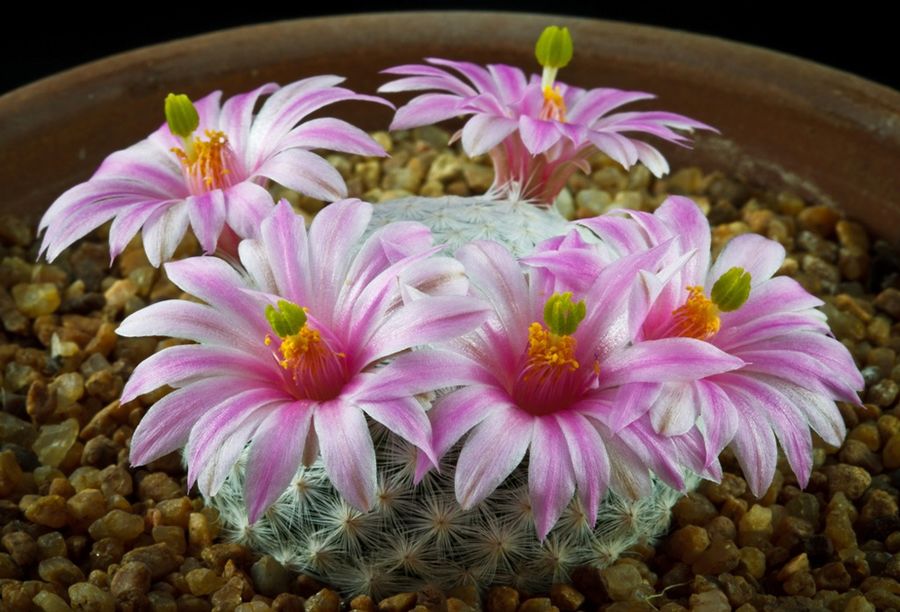
Mammillaria herrerae / Flickr
This cactus is from the genus Mammillaria, which is well known to any cactus grower. The genus itself is very common, but the species Mammillaria herrerae can be found in the wild only in the vicinity of the city of Cadereita (Queretaro state, Mexico), although it is a fairly frequent visitor to the windows of cactus growers. This miniature and very charming cactus, up to 3.5 cm in diameter, produces flowers with a diameter of 2.5 cm. It is precisely due to its popularity among cactus growers and ease of care that the number of wild hererra has decreased by 90% over the past 20 years.
Rodiola-rozovaya
Rare plants of Russia, these are endangered plant species listed in the Red Book.
One of the reasons for the disappearance of plants is human mismanagement. Construction of cities, industrial enterprises, automobile and railways, oil and gas pipelines, plowing of land, as well as general air pollution lead to the fact that some plant species are gradually disappearing.
The work to preserve our natural resources is urgent and an important role belongs to the creation nature reserves and human care for the protection of rare plants.
One of these rare plants is Rhodiola rosea or golden root, Siberian ginseng. A perennial herbaceous plant, a species of the genus Rhodiola, family Crassulaceae, included in the Red Book of Russia. Grows in Altai, the Urals, Eastern and Western Siberia and the Far East. It got its name from its thick rhizome, bronze-colored on the outside, lemon-yellow on the inside, with the smell of rose oil and a bitter-astringent taste. The stems are erect, not branched, soft, up to 50 cm high. The leaves are dark green, elliptical or lanceolate, tender, fleshy. The flowers are small, golden-yellow, turning red before the fruits ripen, and are collected at the tops of the stems in dense corymbose inflorescences. The plant is found on rocky slopes, damp meadows, the banks of mountain rivers and streams, and blooms in June-July.
Rhodiola rosea is a medicinal plant. Rhizomes and roots are used for medicinal purposes. Rhodiola has stimulating properties, increases performance, improves memory and attention, normalizes metabolic processes, improves energy metabolism in muscles and brain, but has a number of contraindications.
Another exquisite and beautiful flower of our forests is Lady's slipper mottled. This rare plant found in Siberia and the Far East, and is listed in the Red Book as an endangered species. This graceful flower lives in coniferous and mixed forests. Two wide, bright green leaves envelop the stem; in mid-June, a peduncle is released, ending in a bud, which will soon turn into an elegant slipper. Three species of this plant grow in our forests - calceolus, makranton and Yatabe's slipper.
Calceolus has a yellow lip, and long petals and the cap of the shoe are burgundy-brown. Sometimes there are two, three or even four flowers on the peduncle. Macranton has the entire flower in a fine mesh of burgundy lines along a lilac or red-violet field.
Yatabe's slipper is motley with yellow and purple specks. Even a single flower of the Lady's slipper is very impressive, and when you see many flowers it will take your breath away with admiration. These flowers smell amazing, they exude an exquisite aroma and everyone has their own. All shoes take a very long time to develop and bloom only in the eighteenth year.
Beautiful rare plants Russia and it is necessary to take care of this wealth of our nature and preserve it from barbaric destruction.
10K 23
We present to your attention a selection of rare atmospheric historical photographs, the historicity of which is emphasized not only by the black and white retro format, but also by the content, which is often difficult to believe! Take a look at these pictures and you will get goosebumps from how different life in those distant times was from ours today. Although, of course, there are general points. And this adds even more goosebumps!
1. The Oldest Known Selfie (1839)
Robert Cornelius took this photo on the street in front of the store his family owned. The photograph became known as the first self-portrait, or as we say today, “selfie.”
2. Cop on a Harley and an old mobile holding cell (1921)

3. Two winners of the 1922 beauty contest

4. A couple enjoying a cable car ride on a Sunday afternoon (1923)

5. Implemented project of a mobile library for patients (1928)

6. A zookeeper helps a penguin take a shower with a watering can (1930)

7. One-wheeled motorcycle capable of reaching a maximum speed of 150 km/h (1931)

8. This is how the creators of the famous London double-decker buses proved that there was no danger of the vehicle overturning (1933)

9. Model T “Elevator – Garage” in Chicago (1936)
10. A tiny puppy nestled comfortably between two Russian soldiers (1945)
As you know, forests are not only the lungs of the planet and a storehouse of various berries, mushrooms and medicinal herbs, but also home to many amazing animals. In this regard, we are telling you about some rare animals that live in Russian forests.
Musk deer
This small deer-like animal with fangs lives in the mountain coniferous forests of the Sayans, Altai, Transbaikalia and Primorye. Despite its terrifying appearance, the musk deer feeds exclusively on vegetation. However, the musk deer is notable not only for this, but also for its attractive smell, which lures females for mating. This smell appears due to the musk gland located in the male’s belly next to the genitourinary canal.
As you know, musk is a valuable component of various medicines and perfumes. And it is precisely because of this that musk deer often become the prey of hunters and poachers. Another reason why this unusual animal is considered an endangered species is that its range is shrinking due to increased economic activity humans (mainly with deforestation).
One of the solutions to the problem of preserving the species in wildlife is farm breeding of musk deer and selection of musk from living males. However, breeding musk deer is not as easy as, for example, cows.
Japanese green pigeon
This unusual bird, about 33 cm long and weighing approximately 300 grams, has a bright yellowish-green color. It is common in South-East Asia, but also found in Sakhalin region(Crillon Peninsula, Moneron and South Islands Kurile Islands). The bird inhabits deciduous and mixed forests with an abundance of cherry and bird cherry trees, elderberry bushes and other plants, the fruits of which it feeds on.
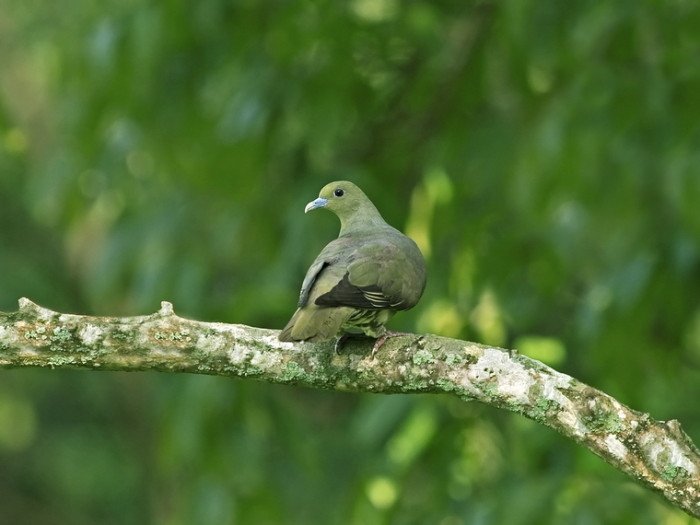 photo: elite-pets.narod.ru
photo: elite-pets.narod.ru The Japanese green pigeon is a rare species, and therefore little is known about its life. Today scientists know that green pigeons are monogamous birds. They weave their nests from thin twigs and place them in trees at a height of up to 20 meters. It is believed that partners hatch eggs in turns for 20 days. And after this, helpless, down-covered chicks are born, which will learn to fly only after five weeks. However, pairs or flocks of green pigeons are rarely seen in Russia; most often they are noticed alone.
Far Eastern or Amur leopards
These graceful cats today inhabit the forests of the Chinese provinces of Jilin and Heilongjiang and the Primorsky Territory of Russia. In this small territory (an area of about 5000 km²), about forty of these cats live today, 7-12 individuals of which live in China, and 20-25 in Russia.
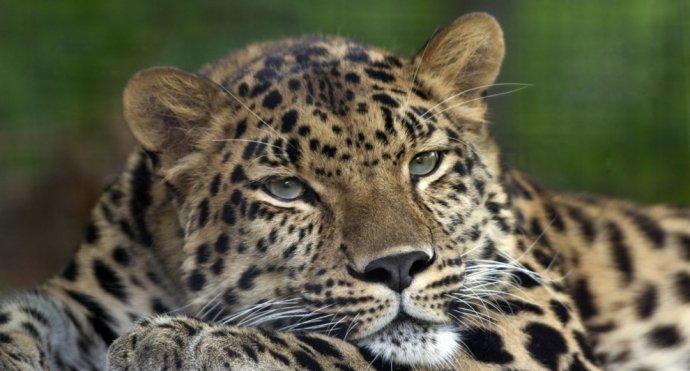 photo: nat-geo.ru
photo: nat-geo.ru Even at the beginning of the 20th century, there were much more rare cats, and their range covered a considerable territory - the eastern and northeastern parts of China, the Korean Peninsula, the Amur, Primorsky and Ussuri territories. However, between 1970 and 1983, the Far Eastern leopard lost 80% of its territory! The main reasons then were forest fires and the conversion of forest areas for agriculture.
Today, the Amur leopard continues to lose its territory and also suffers from a lack of food. After all, roe deer, spotted deer and other ungulates, which this leopard hunts, a huge number killed by poachers. And since the Far Eastern leopard has beautiful fur, it itself is a very desirable trophy for poachers.
Also due to the lack of suitable food in the wild Far Eastern leopards are forced to go looking for her in reindeer herding farms. There, predators are often killed by the owners of these farms. And on top of that, due to the small size of the population of Amur leopards, it will be very difficult for representatives of the subspecies to survive during various disasters like a fire.
However, all this does not mean that the subspecies will soon disappear. Today there are still large areas of forest that provide suitable habitat for the Far Eastern leopard. And if these areas can be preserved and protected from fires and poaching, then the population of these amazing animals in the wild will increase.
Interestingly, Far Eastern leopards are the only leopards that were able to learn to live and hunt in conditions harsh winter. In this, by the way, they are helped by long hair, as well as strong and long legs, which allow them to catch up with prey while moving through the snow. However, Amur leopards not only good hunters, but also exemplary family men. Indeed, sometimes males stay with females after mating and even help them with raising kittens, which, in principle, is not typical for leopards.
Alkina
These butterflies live in the southwest of Primorsky Krai and are found along streams and rivers in mountain forests, where the food plant of the caterpillars of the species, the Manchurian liana, grows. Most often, male butterflies fly to the flowers of this plant, and females most sitting in the grass for a while. Alkinoe females tend to linger on this plant to lay eggs on its leaves.
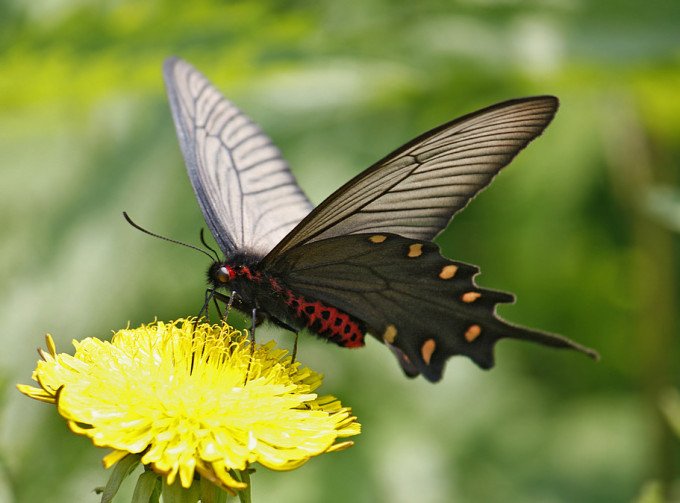 Photo: photosight.ru
Photo: photosight.ru Today, due to disturbance of the habitat of kirkazona and its collection as a medicinal plant, its quantity in nature is decreasing, which, of course, affects the number of alkinoe. On top of everything else, butterflies suffer because they are collected by collectors.
bison
Previously, these animals were widespread in the territory of the former USSR, but by the beginning of the 20th century they survived only in Belovezhskaya Pushcha and in the Caucasus. However, even there their numbers were steadily declining. For example, by 1924, only 5-10 bison remained in the Caucasus. The main reasons for the decline of bison were their extermination by hunters and poachers, as well as destruction during military operations.
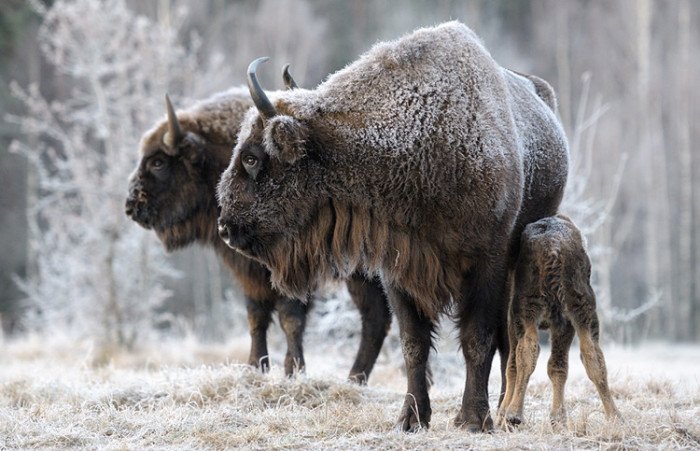 photo: animalsglobe.ru
photo: animalsglobe.ru The restoration of their numbers began in 1940 in the Caucasus Nature Reserve, and now bison inhabit two regions in Russia - the North Caucasus and the center of the European part. In the North Caucasus, bison live in Kabardino-Balkaria, North Ossetia, Chechnya, Ingushetia and the Stavropol Territory. And in the European part there are isolated herds of bison in the Tver, Vladimir, Rostov and Vologda regions.
Bison have always been inhabitants of deciduous and mixed forests, but avoided extensive forest areas. In the Western Caucasus, these animals live mainly at an altitude of 0.9 - 2.1 thousand meters above sea level, often going out into clearings or treeless slopes, but never moving away from forest edges.
In appearance, the bison is very similar to its American relative, the bison. Nevertheless, it is still possible to distinguish them. First of all, the bison has a higher hump and longer horns and tail than the bison. And in the hot months, the back of the bison is covered with very short hair (it even seems that it is bald), while the bison has hair of the same length all over its body at any time of the year.
The bison is listed in the Red Book of Russia as an endangered species and today lives in many nature reserves and zoos.
Fish owl
This species settles along the banks of rivers in the Far East from Magadan to the Amur region and Primorye, as well as on Sakhalin and the Southern Kuril Islands. The fish owl prefers to live in the hollows of old trees with an abundance of aquatic prey nearby, however, old forests and hollow trees are often cut down, which inevitably displaces these birds from their habitats. In addition, fish eagle owls are caught by poachers, and they often fall into traps while trying to pull the bait out of them. The development of water tourism on the Far Eastern rivers and, consequently, increased disturbance of these birds gradually leads to a decrease in the number of eagle owls and interferes with their reproduction. All this has led to the fact that today this species is endangered.
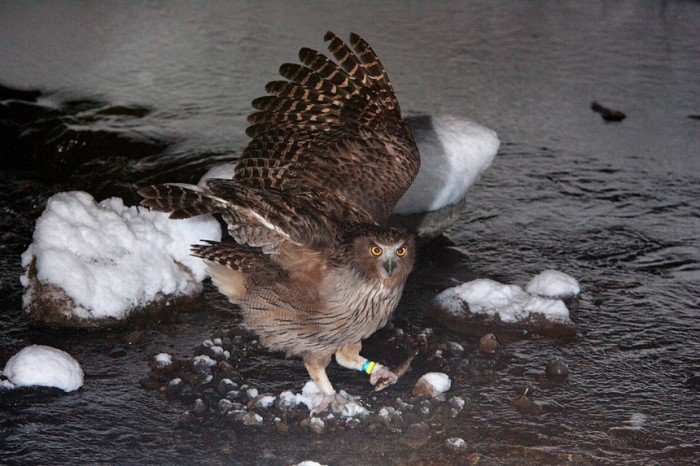 photo: animalbox.ru
photo: animalbox.ru The fish owl is one of the largest owls in the world, as well as the largest member of its genus. Interestingly, these birds can hunt in two different ways. Most often, the fish eagle looks for fish while sitting on a stone in the river, from the shore or from a tree hanging over the river. Having noticed the prey, the eagle owl dives into the water and instantly grabs it with its sharp claws. And when this predator tries to catch sedentary fish, crayfish or frogs, it simply enters the water and probes the bottom with its paw in search of prey.
Giant noctule
This bat, the largest in Russia and Europe, lives in deciduous forests in the territory from the western borders of our country to the Orenburg region, as well as from the northern borders to the Moscow and Nizhny Novgorod regions. There they settle in tree hollows, 1-3 individuals each, in colonies of other bats (usually rufous and lesser noctules).
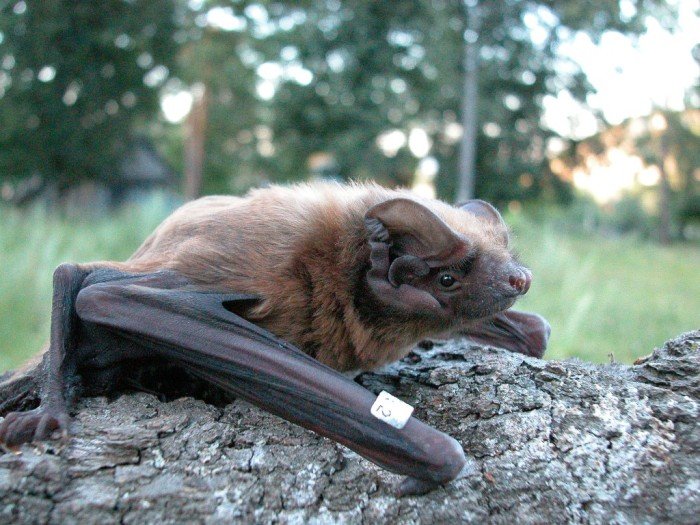 photo: drugoigorod.ru
photo: drugoigorod.ru The giant noctule is rare view, however, ecologists do not know exactly what is causing their low numbers. According to scientists, the threat is posed by deforestation of broad-leaved forests. However, today there are no special measures to protect these animals, since it is not clear what measures will be effective.
It's interesting that these the bats They hunt large beetles and moths, flying over forest edges and ponds. However, analysis of blood and droppings showed that these animals also feed on small birds during migrations, however, this has never been recorded.
Sky barbel
In Russia, in the south of the Primorsky Territory (in the Terneysky, Ussuriysky, Shkotovsky, Partizansky and Khasansky districts) a beetle with a bright blue color lives. It lives in broadleaf forests mainly in the wood of the greenbark maple. There the female beetle lays eggs, and after about half a month the larvae appear. They develop in the wood for about 4 years, and then, in June, the larva gnaws out the “cradle” and pupates. After about 20 days, the beetle emerges from the wood and immediately begins to reproduce. He will spend all his strength on this for the rest of his life, which lasts only two weeks.
 photo: historical-samara.rf
photo: historical-samara.rf The barbel is listed in the Red Book of Russia as a rare species whose numbers are declining. According to environmentalists, the reason for this is deforestation and a sharp decrease in the number of greenbark maples.
Himalayan or white-breasted bear
The Ussuri white-breasted bear inhabits the deciduous forests of the Primorsky Territory and southern regions Khabarovsk Territory and the southeastern part of the Amur region. Until 1998, it was listed in the Red Book of Russia as a rare species, and today it is a hunting species. However, if in the 90s its population was 4-7 thousand individuals, now this bear is on the verge of extinction (its population is up to 1 thousand individuals). The reason for this was, first of all, deforestation and mass hunting. The latter, by the way, was discussed during the international environmental forum “Nature without Borders” in Vladivostok, after which in 2006 a decision was made in the Primorsky Territory to introduce restrictions on hunting the Himalayan bear during hibernation.
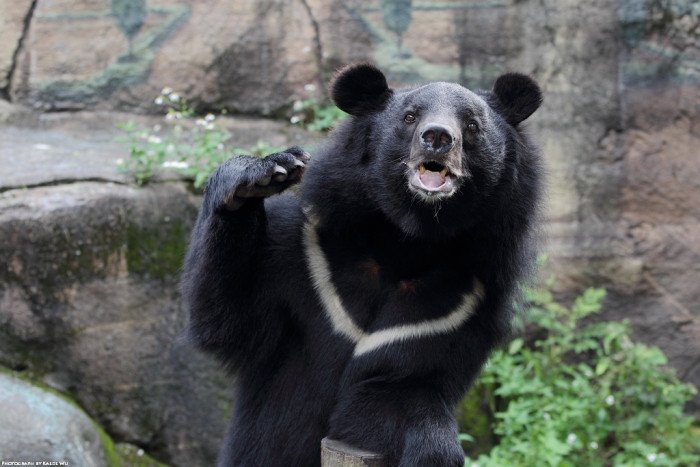 Photo: myplanet-ua.com
Photo: myplanet-ua.com The white-breasted bear leads a semi-arboreal lifestyle: it gets food in trees and hides from enemies (these are mainly Amur tigers and brown bears). Almost the entire diet of this bear consists of plant foods, in particular nuts, fruits and berries, as well as shoots, bulbs and rhizomes. It also does not refuse to feast on ants, insects, mollusks and frogs.
Black stork
This is a widespread but rare species, whose numbers are declining due to human economic activity, manifested in the clearing of forests and drainage of swamps. Today the bird is found in forests from Kaliningrad and Leningrad regions before Southern Primorye. The black stork prefers to settle near bodies of water in deep, old forests.
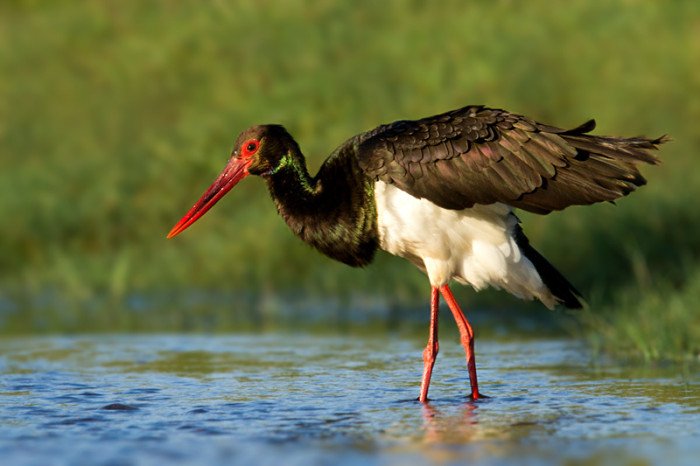 photo: Lisa 013
photo: Lisa 013 Exactly there, on the old tall trees(and sometimes on rock ledges) black storks build nests, which they will then use for several years. When the time comes to invite the female to the nest (around the end of March), the male fluffs up his white undertail and begins to emit a hoarse whistle. The eggs laid by the female (from 4 to 7 pieces) will be incubated by the partners in turn until the chicks hatch from them after 30 days.
Red or mountain wolf
This representative of the animal world has a body up to 1 meter long and can weigh from 12 to 21 kg. Outwardly, it can be confused with a fox, and this is precisely one of the main reasons for its extinction. Hunters who know a little about animals shoot mountain wolves in large numbers.
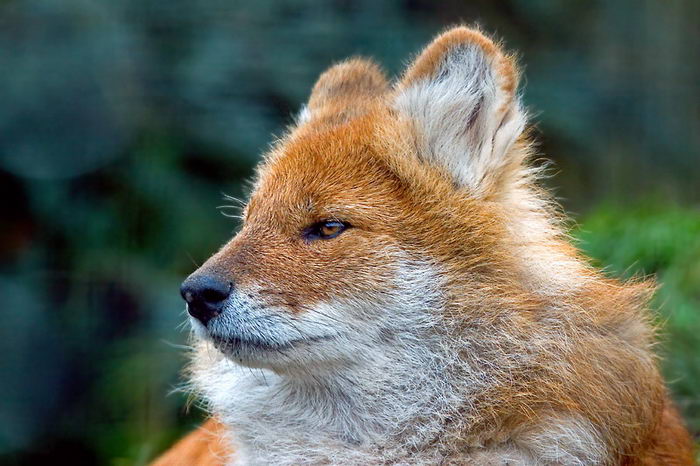 Photo: natureworld.ru
Photo: natureworld.ru He attracted people's attention with his fluffy fur, which has a beautiful bright red color. It is also worth noting that his tail is slightly different from a fox's, having a black tip. The habitat of this wolf is the Far East, China and Mongolia.
Przewalski's horse
The Przewalski's horse is the only species of wild horse remaining on our planet. The ancestors of all domestic horses were other wild horses - tarpans, now extinct. In addition to the tarpan, a close relative of the Przewalski's horse can be considered the Asian donkey - the kulan.
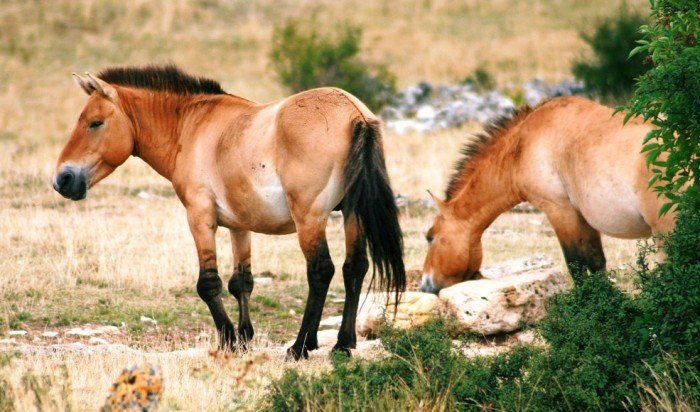 Photo: animalsglobe.ru
Photo: animalsglobe.ru The Przewalski's horse is considered a primitive species and, along with equines, retains some characteristics of a donkey. It differs from domestic horses in its dense build, short, strong neck, and low legs. Her ears are small, but her head, on the contrary, is large and heavy, like a donkey’s. A distinctive feature of wild horses is a stiff, erect mane without bangs. The color of Przewalski's horses is red with a lighter belly and muzzle. The mane, tail and legs are black.
Due to a lack of food resources and hunting, Przewalski's horses completely disappeared in nature by the 60s of the 20th century. But a large number of these animals are preserved in zoos around the world. As a result of painstaking work, it was possible to overcome the problems with closely related crossing of Przewalski's horses and some of the individuals were released in the Khustan-Nuru Nature Reserve (Mongolia).
Interesting fact— as an experimental project, in the early 1990s, several individuals were released into the wild, and not just somewhere, but into the exclusion zone of the Chernobyl nuclear power plant. There they began to multiply, and now there are about one hundred of them in the zone.
Amur goral
The Amur goral is a subspecies of mountain goat named Goral, found in the Primorsky Territory in the amount of 600-700 goats and goats. Protected by the state. Friends and relatives of the Amur goral live in the Himalayas and Tibet, and correspond with the Amur goral extremely rarely.
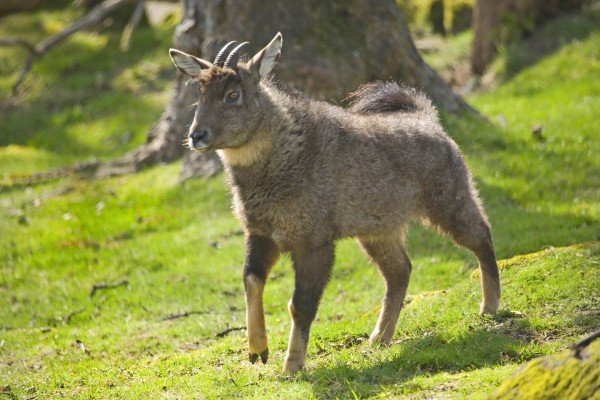 Photo: entertainmentstar.blogspot.com
Photo: entertainmentstar.blogspot.com Goral is afraid of the wolf and often dies from its arrogant teeth. In general, it seems that wolves are the most important goats. In fact, only a real goat can calmly eat the Amur goral, which is listed in the Red Book.
Western Caucasian tur or Caucasian mountain goat
The West Caucasian Tur lives in the Caucasus Mountains, namely along the Russian-Georgian border. It was recorded in the Red Book of Russia “thanks to” human activity, as well as due to mating with the East Caucasian aurochs. The latter leads to the birth of infertile individuals.
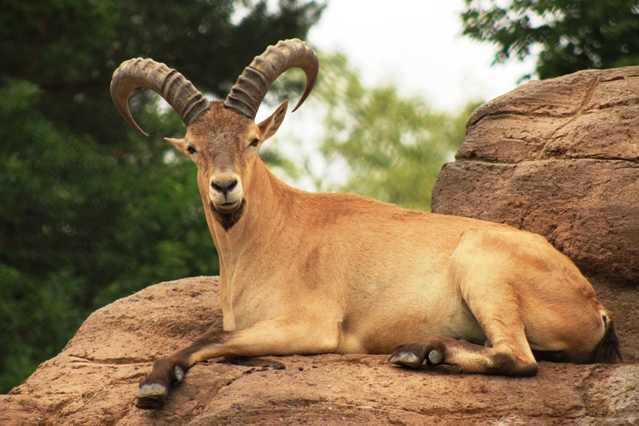 Photo: infoniac.ru
Photo: infoniac.ru The number of these animals in the wild today is estimated at 10 thousand individuals. The International Union for Conservation of Nature gives Western Caucasian tur status “in danger”.
Asiatic cheetah
Previously, it could be found on a vast territory that stretched from the Arabian Sea to the valley of the Syrdarya River. Today in nature there are only about 10 individuals of this rare species, and in all zoos in the world you can count 23 representatives of the Asian cheetah.
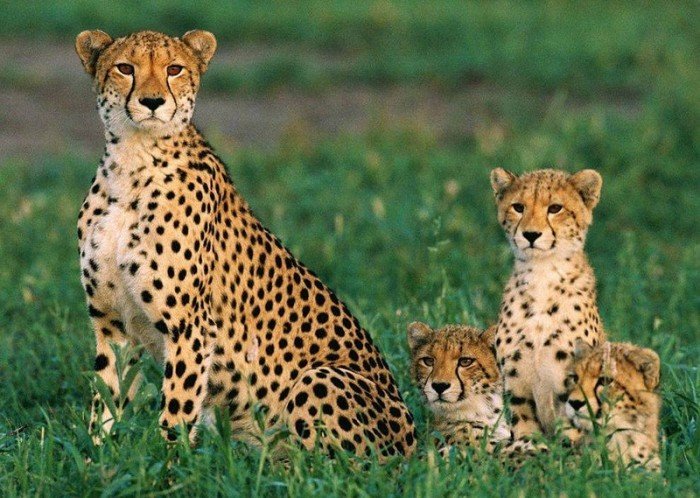 Photo: murlika.msk.ru
Photo: murlika.msk.ru The Asiatic cheetah is not much different in appearance from its African counterpart. An elegant body without a single hint of fat deposits, a powerful tail and a small muzzle, decorated with pronounced “tear tracks”. However, genetically these subspecies differ so much that the African cat will not be able to replenish the population of Asians.
The reasons for the disappearance of this animal were interference in the lives of human cats and the lack of their main food - ungulates. The predator cannot meet its nutritional needs with hares and rabbits and often attacks domestic animals.
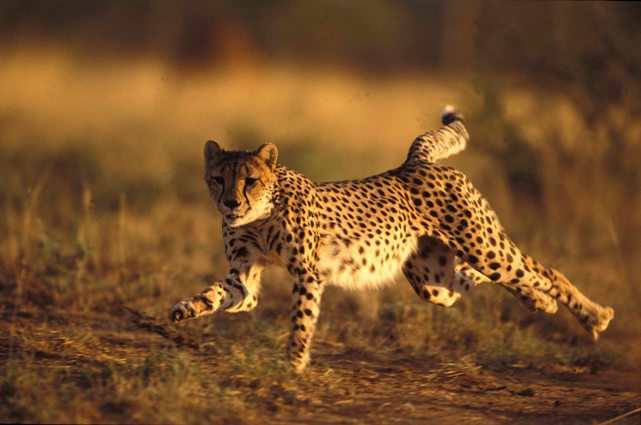 Photo: infoniac.ru
Photo: infoniac.ru This aristocratic cat considers it unworthy to hide in ambush during a hunt. It silently approaches the potential victim at a distance of up to 10 meters and instantly picks up a huge speed of up to 115 km/h and catches up with the prey, knocking down even large animals with a blow of its paw, and then strangling the victim. A hunter needs only 0.5 seconds to jump 6-8 meters long. However, the chase lasts only about 20 seconds; the cat spends too much energy on such a super-powerful jerk; the breathing rate in such a race exceeds 150 times per minute. Half the chases are unsuccessful, and while the cheetah is resting, its prey is often taken by larger cats. However, an Asian will never eat leftovers from other animals or carrion. Rather, he would prefer to go hunting again.
Probably, these beauties almost went extinct during the Ice Age, all representatives are close relatives, and even without human intervention, signs of inbreeding and extinction are clearly visible. There is too much mortality among cheetah kittens, more than half of them do not live to be 1 year old. In captivity, these predators practically do not produce offspring. In ancient times, when these hunting cats occupied a worthy place in the courts of high nobles and did not need anything, the birth of kittens was very rare.
Amur tiger
The Amur tiger is the largest tiger in the world. And the only one of the tigers who has mastered life in the snow. No other country in the world has such an asset. Without exaggeration, this is one of the most advanced predators among all others. Unlike the lion, which forms prides (families) and lives through collective hunts, the tiger is a distinct loner, and therefore requires the highest skill in hunting.
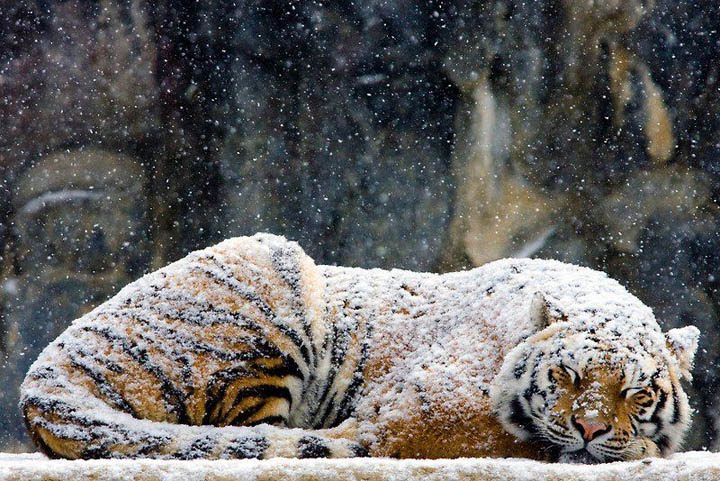 Photo: ecamir.ru
Photo: ecamir.ru The tiger crowns the top of the food pyramid of a unique ecological system called the Ussuri taiga. Therefore, the state of the tiger population is an indicator of the state of the entire Far Eastern nature.
The fate of the Amur tiger is dramatic. In the middle of the 19th century it was numerous. At the end of the 19th century. Up to 100 animals were hunted annually. In the thirties of the last century, the tiger was occasionally found only in the most remote corners of the Ussuri taiga, difficult to reach by humans. The Amur tiger is on the verge of extinction due to unregulated shooting of adult individuals, intensive capture of tiger cubs, clearing of forests in the vicinity of some rivers and a decrease in the number of wild artiodactyl animals caused by increased hunting pressure and other reasons; Winters with little snow also had an adverse effect.
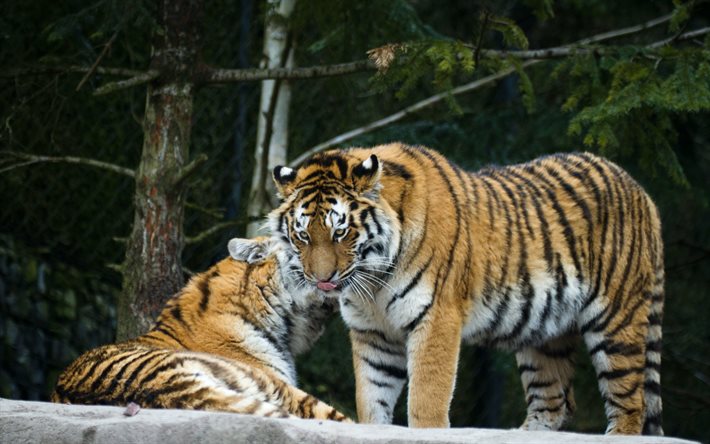 Photo: brightwallpapers.com.ua
Photo: brightwallpapers.com.ua In 1935, a large and one-of-a-kind Sikhote-Alin State Nature Reserve was organized in the Primorsky Territory. Somewhat later - Lazovsky and Ussuriysky nature reserves. Since 1947, tiger hunting was strictly prohibited. Even the capture of tiger cubs for zoos was allowed only on occasion, with special permits. These measures turned out to be timely. Already in 1957, the number of Amur tigers almost doubled compared to the thirties, and by the early sixties it exceeded one hundred. The Amur tiger is protected by the state - it is listed in the Red Book Russian Federation, hunting and trapping of tigers is prohibited.
Since 1998, the federal target program “Conservation of the Amur Tiger”, approved by the Government of the Russian Federation, has been implemented. There are just over 500 Amur tigers left in the Far East. The country has a presidential program to protect them. Without exaggeration, every animal has a special place.
